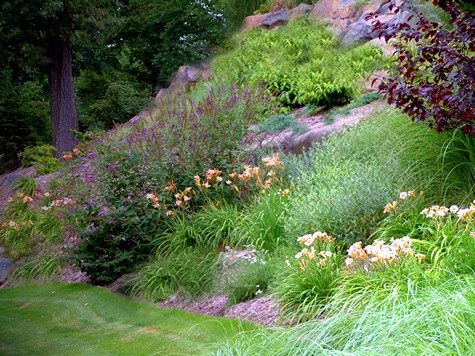Find expert tips on Steep hill landscaping that lasts for years.
Accomplish a Lovely Exterior Sanctuary With Thoughtful Steep Hillside Landscape Design Solutions
Changing a steep hillside right into an exciting outside oasis presents unique obstacles that need innovative landscape design options. By attending to issues such as disintegration control and availability, one can create an unified blend of elegance and performance. Methods such as terracing, the setup of keeping wall surfaces, and the choice of native plants play essential functions in this procedure. Furthermore, including water functions can better improve the landscape's attraction. Nevertheless, understanding the ins and outs of these elements is necessary for achieving an absolutely cohesive and welcoming environment. What techniques will best match your hillside's details features?
Understanding Steep Hillside Obstacles
Landscaping on steep hillsides presents one-of-a-kind challenges that call for mindful factor to consider and tactical preparation. The inclination of the surface can lead to issues such as soil erosion, water overflow, and limited access, every one of which need to be addressed to produce a useful and cosmetically pleasing outdoor room.
One of the key interest in high hill landscape design is erosion, which can arise from heavy rainfall or incorrect drainage. This not only affects plant wellness but can also endanger the stability of the slope. Executing effective erosion control steps, such as planting ingrained vegetation or utilizing mulch, is necessary in protecting the integrity of the landscape.

Creating With Terracing Methods
To minimize the challenges posed by steep hillsides, integrating terracing methods can be an efficient solution. This style method transforms a sloped landscape right into a series of level, degree areas, creating a visually striking and functional outdoor space. Terracing not just assists to avoid dirt erosion yet also assists in far better water drainage, which is critical in preserving the health and wellness of plants and the security of the hill.
When making terraces, careful consideration of the incline's angle and the dirt type is crucial. Each terrace should be tactically put to maximize sunshine direct exposure while decreasing the danger of overflow. Using indigenous plants on each degree can enhance biodiversity, promote sustainability, and lower upkeep requirements. In addition, integrating paths in between balconies can boost accessibility and encourage expedition of the landscape.
Terraced yards can serve several purposes, consisting of vegetable production, ornamental screens, or outdoor seats locations. By using products that mix sympathetically with the surrounding atmosphere, the terracing can enhance the general aesthetic appeal of the residential property. visit the site Inevitably, thoughtful terracing changes steep hills into practical, lovely rooms that invite communication and satisfaction.
Implementing Retaining Walls
When encountered with the challenges of high terrain, executing keeping walls can give both structural assistance and visual improvement to a landscape. These walls serve to avoid soil erosion, maintain inclines, and develop flat areas for gardening or recreational usage. Steep hill landscaping. By efficiently handling water overflow and minimizing dirt activity, maintaining wall surfaces shield your landscape investment while enhancing safety and security

Specialist setup is critical to ensure the long life and performance of preserving walls. Correct drainage systems must be integrated to alleviate hydrostatic stress, stopping architectural failing. Consulting with landscape professionals will make sure that the style lines up with your total vision while adhering to neighborhood regulations.
Deciding On Indigenous Plants
Selecting indigenous plants for your landscape design supplies many eco-friendly and aesthetic benefits. Steep hill landscaping. Indigenous plants are adapted to the neighborhood climate and soil conditions, calling for much less water and upkeep compared to non-native types. This adaptability not only preserves sources yet additionally promotes a visit homepage healthier ecosystem, as native plants support local wildlife, consisting of pollinators such as bees and butterflies
Integrating indigenous vegetation right into your steep hillside landscape design can improve soil security, decreasing erosion and promoting a balanced ecological community. Ingrained indigenous plants aid anchor the dirt, making them suitable for sloped locations. Furthermore, these plants usually exhibit lively colors and diverse structures, developing a visually appealing landscape that integrates with the surrounding environment.
When choosing native plants, consider their growth routines, seasonal interest, and compatibility with various other varieties. Organizing plants with comparable water and sunshine demands can result in a more natural design, while also streamlining maintenance. By choosing indigenous plants, you not just cultivate a lasting outside sanctuary yet also contribute favorably to the regional biodiversity, making certain that your landscape flourishes for several years to come.
Incorporating Water Attributes
Including water functions right into your high hill landscape design can significantly enhance both the visual charm and environmental functionality of the room. The sound of flowing water creates a peaceful ambience, while aesthetically, it can act as a focal point that draws the eye and includes depth to the landscape.
When choosing water attributes, think about options that match the all-natural shapes of your hillside. Waterfalls, for example, can cascade the slope, developing visual interest and promoting healthy water drainage. Ponds can also be integrated right into the style, urging regional wildlife and giving habitats for different species.
Additionally, the positioning of plants around these attributes is crucial. Native marine plants not just enhance the elegance of the water attribute but likewise contribute to its environmental balance by filtering contaminants and providing food for local animals.
Upkeep is another crucial aspect; guarantee that your water attribute is made for simple maintenance. An appropriately created feature will require minimal intervention, allowing you to enjoy the beauty and peace it provides without excessive labor. Eventually, thoughtfully incorporated water functions can change your high hill landscape into an exciting outdoor sanctuary.
Final Thought
In conclusion, transforming a steep hillside right into a lovely outdoor sanctuary demands thoughtful landscape design strategies that address disintegration control and ease of access. The integration of terracing methods, the application of retaining walls, and the choice of indigenous plants are vital components of efficient style.